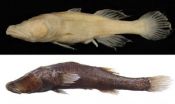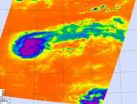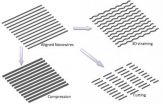(Press-News.org) A study in the August 30 issue of Nature provides, in unprecedented detail, the history of a crucial indicator of the relationship between the carbon cycle and climate processes over the past 55 million years. Over this time period, when the Earth is known to have transitioned from "hothouse" to "icehouse" conditions, the oceans also experienced a dramatic shift in the carbonate compensation depth, or CCD. Defined as the depth below which carbonate minerals (such as calcite) dissolve completely, the CCD is known to fluctuate over time – it shallows during warm periods, and deepens when ice age conditions prevail. Now, however, scientists have a detailed and quantifiable record of just how much the CCD has shifted during recent geological history.
The study, which relies on seafloor sediment cores collected during a pair of 2009 expeditions on board the JOIDES Resolution, demonstrates that 55 million years ago, the CCD of the Pacific Ocean sat at an average of about two miles (3.3-3.6 km) below the sea surface. As the Earth cooled, however, the CCD sank – reaching its deepest point of almost three miles (4.8 km) between 13 and 11 million years ago. Today, the Pacific's CCD sits just less than three miles (4.5 km) deep, and is thought to be on the rise as a result of modern, human-induced climate change.
"Long-term change in CCD and changes in Earth's atmospheric carbon dioxide concentration both result from shifts in how carbon is cycled by earth processes," says study co-author Mitchell Lyle, a geoscientist at Texas A&M University who co-led the second of the two expeditions. "Adding geologic reserves of carbon into the oceans and atmosphere – by burning coal or petroleum, for example – causes oceans to become more acidic and causes the atmosphere and oceans to warm. This new CCD record is an important step toward understanding how the carbon system balances out over long time frames."
The Pacific Ocean has remained the largest ocean on Earth for millions of years. Today, it covers one third of the planet's surface, and its biologically productive equatorial region plays a very important role in the global carbon cycle and long-term climate patterns. Over four months, the drilling vessel JOIDES Resolution – operated by the U.S. Implementing Organization on behalf of the National Science Foundation (NSF) and the Integrated Ocean Drilling Program (IODP) – drilled nearly four miles of core samples at eight different locations across the center of the Pacific basin.
"We often discuss global warming induced by man-made carbon dioxide. However, on geological timescales of millions of years, other processes determine the carbon cycle," says lead author Heiko Pälike, a geoscientist at the University of Bremen who co-led the first expedition. Volcanoes are a major natural source of atmospheric carbon dioxide, while the weathering of carbonate rocks can remove the gas from the atmosphere. "The overall balance of these processes is reflected in the CCD," explains Pälike.
In the Nature study, Pälike, Lyle and their co-authors demonstrate that, in the equatorial Pacific, the CCD did not follow a one-way path to the depths as the planet cooled down. Rather, the data reveals five intervals in the "greenhouse" world (prior to 33 million years ago) during which the CCD fluctuated upwards and downwards in a range between 650 and 3,000 feet (200-900 meters), and at least four more major excursions in the last 20 million years. "These events, which often mirror warming and cooling phases, persisted between 250,000 and one million years," Pälike explains. They resulted from minor differences between how much calcium was added to the oceans by weathering versus how much carbon dioxide was added to the ocean-atmosphere system by volcanic eruptions. The cycling of carbon between the sea surface and deep ocean further complicated the situation.
"Understanding the processes that caused these CCD excursions will provide important new insights about how the carbon cycle and climate are linked," Lyle says. "And, they will help us better understand how and when the current spike in atmospheric carbon dioxide will eventually level out."
### To access more data and information from the Pacific Equatorial Age Transect (PEAT) expeditions, please see: http://publications.iodp.org/proceedings/320_321/32021toc.htm
The paper, titled "A Cenozoic record of the equatorial Pacific carbonate compensation depth," appears in the August 30, 2012 issue of the journal Nature. (doi:10.1038/nature11360)
About IODP
The Integrated Ocean Drilling Program (IODP) is an international research program dedicated to advancing scientific understanding of the Earth through drilling, coring and monitoring the subseafloor. The JOIDES Resolution is a scientific research vessel managed by the U.S. Implementing Organization of IODP (USIO). Together, Texas A&M University, Lamont-Doherty Earth Observatory of Columbia University, and the Consortium for Ocean Leadership comprise the USIO. IODP is supported by two lead agencies: the U.S. National Science Foundation (NSF) and Japan's Ministry of Education, Culture, Sports, Science, and Technology. Additional program support comes from the European Consortium for Ocean Research Drilling (ECORD), the Australia-New Zealand IODP Consortium (ANZIC), India's Ministry of Earth Sciences, the People's Republic of China (Ministry of Science and Technology), and the Korea Institute of Geoscience and Mineral Resources. For more information, visit www.iodp.org.
Connect with us online!
Web: www.joidesresolution.org
Facebook: http://www.facebook.com/theJR
Twitter: @theJR and @SeafloorSci
Media Contacts:
Mitchell Lyle
Texas A&M University
College Station, Texas, USA
mlyle@ocean.tamu.edu
+1-979-845-3380
Matthew Wright Consortium for Ocean Leadership
Washington, D.C. USA
mwright@oceanleadership.org
+1-202-448-1254
Heiko Pälike
MARUM, University of Bremen
Bremen, Germany
hpaelike@marum.de
+49-421-218-65980
Albert Gerdes
MARUM, University of Bremen
Bremen, Germany
agerdes@marum.de
+49-421-218-65540
More news about Texas A&M University, go to http://tamutimes.tamu.edu/
Follow us on Twitter at http://twitter.com/tamu/
New Nature study illuminates 55 million years of the carbon cycle and climate history
2012-08-30
ELSE PRESS RELEASES FROM THIS DATE:
Computer viruses could take a lesson from showy peacocks
2012-08-30
EAST LANSING, Mich. — Computer viruses are constantly replicating throughout computer networks and wreaking havoc. But what if they had to find mates in order to reproduce?
In the current issue of Evolution, Michigan State University researchers created the digital equivalent of spring break to see how mate attraction played out through computer programs, said Chris Chandler, MSU postdoctoral researcher at MSU's BEACON Center for the Study of Evolution in Action.
"This is actually a big question that still generates a lot of debate," said Chandler, who co-authored the ...
Eyeless Australian fish have closest relatives in Madagascar
2012-08-30
A team of researchers from Louisiana State University and the American Museum of Natural History has discovered that two groups of blind cave fishes on opposite sides of the Indian Ocean are each other's closest relatives. Through comprehensive DNA analysis, the researchers determined that these eyeless fishes, one group from Madagascar and the other from similar subterranean habitats in Australia, descended from a common ancestor before being separated by continental drift nearly 100 million years ago. Their study, which appears in the journal PLOS ONE this week, also ...
Heatwaves to move toward coasts, study finds
2012-08-30
A new study by researchers at Scripps Institution of Oceanography, UC San Diego, suggests that the nature of California heatwaves is changing due to global warming.
Climate researchers Alexander Gershunov and Kristen Guirguis detected a trend toward more humid heatwaves that are expressed very strongly in elevated nighttime temperatures, a trend consistent with climate change projections. Moreover, relative to local warming, the mid-summer heatwaves are getting stronger in generally cooler coastal areas. This carries implications for the millions of Californians living ...
Physics faculty try innovative teaching methods
2012-08-30
A study of physics faculty awareness and use of research-based instructional techniques offers greater understanding of what is missing from current education reform efforts
The world has changed dramatically in recent decades but many argue that the university system has not kept pace. As another academic year begins, if you peek into any introductory college science course you're likely to find the same scene as you would have twenty years ago: An instructor writing equations on the blackboard while a lecture hall full of students take notes.
Why is college science ...
Study shows hope of greater global food output, less environmental impact of agriculture
2012-08-30
MINNEAPOLIS / ST. PAUL (08/29/2012) —Can we have enough to eat and a healthy environment, too? Yes—if we're smart about it, suggests a study published in Nature this week by a team of researchers from the University of Minnesota and McGill University in Montreal.
Global demand for food is expected to double by 2050 due to population growth and increased standards of living. To meet this demand, it is often assumed we will need to expand the environmental burden of agriculture. The paper, based on analysis of agricultural data gathered from around the world, offers hope ...
Collagen-seeking synthetic protein could lead doctors to tumor locations
2012-08-30
Johns Hopkins researchers have created a synthetic protein that, when activated by ultraviolet light, can guide doctors to places within the body where cancer, arthritis and other serious medical disorders can be detected.
The technique could lead to a new type of diagnostic imaging technology and may someday serve as a way to move medications to parts of the body where signs of disease have been found. In a study published in the Aug. 27-31 Online Early Edition of Proceedings of the National Academy of Sciences, the researchers reported success in using the synthetic ...
Controlling gait of horses may be possible, says key study from Texas A&M
2012-08-30
COLLEGE STATION Aug. 29, 2012 – Analysis of a specific mutation in a gene in horses that affects the ability of horses to use alternate gaits is strongly related to racing performance and is advantageous for harness-racing horses. In domestic horses, the mutation has had a major impact on their diversification, as the altered gait characteristics of a number of breeds apparently require this mutation, according to a study that includes a Texas A&M University researcher.
Gus Cothran, a professor in the Animal Genetic Lab of the College of Veterinary Medicine & Biomedical ...
Tropical Storm Kirk looks more like a comet on NASA infrared imagery
2012-08-30
Tropical Storm Kirk looks more like a comet than a tropical storm in infrared imagery from NASA's Aqua satellite because of wind shear. NASA infrared imagery also revealed powerful thunderstorms around the center of circulation which are indicators that Kirk will continue strengthening. Meanwhile, another low pressure area appears to be organizing in the eastern Atlantic, far to the southeast of Kirk.
Tropical Depression Kirk formed from the eleventh tropical depression of the Atlantic Ocean season. Tropical Depression 11 formed on Aug. 28 at 5 p.m. EDT about 1,270 miles ...
NASA sees Hurricane Isaac make double landfall in Louisiana
2012-08-30
Hurricane Isaac made two landfalls in southeastern Louisiana. Isaac's first landfall occurred in southeastern Louisiana on Aug. 28 at 7:45 p.m. EDT (1145 UTC), second landfall on Aug. 29 at 6 a.m. EDT (1000 UTC). NASA's TRMM satellite observed heavy rainfall in this slow moving storm, which leads to higher rainfall totals and flooding.
NASA and NOAA satellites continue to provide detailed information to forecasters at the National Hurricane Center. Hurricane Isaac's first landfall occurred at 7:45 p.m. EDT in extreme southeastern Louisiana, bringing strong winds and dangerous ...
'Nano machine shop' shapes nanowires, ultrathin films
2012-08-30
WEST LAFAYETTE, Ind. –A new "nano machine shop" that shapes nanowires and ultrathin films could represent a future manufacturing method for tiny structures with potentially revolutionary properties.
The structures might be "tuned" for applications ranging from high-speed electronics to solar cells and also may have greater strength and unusual traits such as ultrahigh magnetism and "plasmonic resonance," which could lead to improved optics, computers and electronics.
The researchers used their technique to stamp nano- and microgears; form tiny circular shapes out of ...




